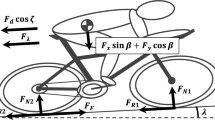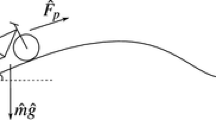Abstract
We formulate a phenomenological model to study the power applied by a cyclist on a velodrome—for individual timetrials—taking into account the straights, circular arcs, connecting transition curves, and banking. The dissipative forces we consider are air resistance, rolling resistance, lateral friction and drivetrain resistance. Also, in general, the power is used to increase the kinetic and potential energy. However, to model a steady ride—as expected for individual timetrials—we assume a constant centre-of-mass speed and allow the cadence and power to vary during a lap. Hence, the only mechanical energy to consider is the increase of potential energy due to raising the centre of mass upon exiting each curve. Following derivations and justifications of expressions that constitute this mathematical model, we present a numerical example. We show that, as expected, the cadence and power vary only slightly during a steady ride. In addition, we examine changes in the required average power per lap due to modifications of various quantities, such as air density at a velodrome, laptime and several others. Such an examination is of immediate use in strategizing the performance for individual pursuits and the Hour Record.







Similar content being viewed by others
Data availability
Not applicable.
References
Benham GP, Cohen C, Brunet E, Clanet C (2020) Brachistochrone on a velodrome. Proceedings of the Royal Society A 476(2238)
Bohren CF, Albrecht BA (1998) Atmospheric thermodynamics. Oxford University Press
Bos L, Slawinski MA, Slawinski RA, Stanoev T (2021) On modelling bicycle power for velodromes: Part II. Formulation for individual pursuits. arXiv:2009.01162 [physics.app-ph]. Version 08.01.2021
Danek T, Slawinski MA, Stanoev T (2021) On modelling bicycle power-meter measurements. arXiv 2103.09806 [physics.pop-ph]
Dwyer DB (2014) The effect of environmental conditions on performance in timed cycling events. J Sci Cycling 3(3):17–22
Fitton B, Symons D (2018) A mathematical model for simulating cycling: applied to track cycling. Sports Eng 21:409–418
Fitton B, Caddy O, Symons D (2018) The impact of relative athlete characteristics on the drag reductions caused by drafting when cycling in a velodrome. Proc Inst Mech Eng Part P 232(1):39–49
Fitzgerald S, Kelso R, Grimshaw P, Warr A (2021) Impact of transition design on the accuracy of velodrome models. Sports Eng 24(23)
Lowrie W (2007) Fundamentals of Geophysics, 2nd edn. Cambridge University Press
Lukes R, Hart J, Haake S (2012) An analytical model for track cycling. Proc Inst Mech Eng Part P 226(2):143–151
Martin JC, Milliken DL, Cobb JE, McFadden KL, Coggan AR (1998) Validation of a mathematical model for road cycling power. J Appl Biomech 14(3):276–291
Sankar Mohanta B, Kumar A (2023) A parametric analysis on the performance of vehicle tires. Mater Today 81:238–241
Solarczyk MT (2020) Geometry of cycling track. Budownictwo i Architektura 19(2):111–119. 10.35,784/bud-arch.1621
Stanoev T (2023) On technical considerations of velodrome track design. Sports Engineering 26(36):(Link: https://rdcu.be/dhgLE), https://doi.org/10.1007/s12283-023-00425-5
Underwood L, Jermy M (2010) Mathematical model of track cycling: the individual pursuit. Proc Eng 2(2):3217–3222
Underwood L, Jermy M (2014) Determining optimal pacing strategy for the track cycling individual pursuit event with a fixed energy mathematical model. Sports Eng 17:183–196
Author information
Authors and Affiliations
Corresponding author
Ethics declarations
Conflict of interest
The authors declare that they have no conflict of interest.
Additional information
Publisher's Note
Springer Nature remains neutral with regard to jurisdictional claims in published maps and institutional affiliations.
Rights and permissions
Springer Nature or its licensor (e.g. a society or other partner) holds exclusive rights to this article under a publishing agreement with the author(s) or other rightsholder(s); author self-archiving of the accepted manuscript version of this article is solely governed by the terms of such publishing agreement and applicable law.
About this article
Cite this article
Bos, L., Slawinski, M.A., Slawinski, R.A. et al. Modelling of a cyclist’s power for time trials on a velodrome. Sports Eng 27, 9 (2024). https://doi.org/10.1007/s12283-024-00451-x
Accepted:
Published:
DOI: https://doi.org/10.1007/s12283-024-00451-x




